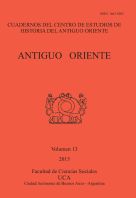Please use this identifier to cite or link to this item:
https://repositorio.uca.edu.ar/handle/123456789/6620| Título: | Aq “enter”, but how, and where? Data from the coffin texts “entrar” ¿Pero cómo, y dónde? Información de Textos de los Sarcófagos |
Autor: | Gracia Zamacona, Carlos | Palabras clave: | SEMANTICA; VERBOS; INSCRIPCIONES; ORIENTE ANTIGUO; LENGUAJE NATURAL; TEXTOS ANTIGUOS; HISTORIA DE EGIPTO | Fecha de publicación: | 2015 | Editorial: | Pontificia Universidad Católica Argentina. Facultad de Ciencias Sociales. Centro de Estudios de Historia del Antiguo Oriente | Cita: | Gracia Zamacona, C Aq “enter”, but how, and where? : data from the coffin texts [en línea]. Antiguo Oriente. Cuadernos del Centro de Estudios de Historia del Antiguo Oriente. 2015, 13 Disponible en: https://repositorio.uca.edu.ar/handle/123456789/6620 | Resumen: | Abstract: The verb ao “enter” displays special semantic features, in valency, and Aktionsart, among the general way of expressing space with motion verbs: ao is an achievement with no prephase, and with a stative postphase, and its action is mainly performed at the limit (“access”) of the illative spatial complement. This phenomenon is shown by the use of the preposition r with sharply delimited complements, while the usual preposition for illative, m, is used with unlimited complements—respectively, objects, and substances according to Johnson and Lakoff’s terminology in their book Metaphors We Live By (1980, 30). This peculiarity constitutes an extreme case study, and reveals the relevance of a semantic approach when based upon large textual corpora (in this study, the Coffin Texts) in explaining specific morphosyntactic particularities such as the prepositions used with the illative of this verb. This approach also allows for the testing of certain significant theoretical concepts such as the cognitive schema “container,” with data from a natural language such as Ancient Egyptian. Resumen: Si lo comparamos con la manera general en que los verbos de movimiento expresan las relaciones espaciales, el verbo ao, “entrar”, presenta unos rasgos semánticos particulares en cuanto a su valencia y Aktionsart: ao es un logro sin prefase y con posfase estática, cuya acción se produce con mayor frecuencia en el límite (“acceso”) del complemento espacial ilativo. Este fenómeno se refleja en el uso de la preposición r con los complementos claramente delimitados, mientras que se emplea la preposición usual del ilativo (m) con los complementos no delimitados—respectivamente, objetos y sustancias en la terminología de Johnson y Lakoff en su libro Metaphors We Live By (1980, 30). Esta peculiaridad constituye un estudio de caso extremo que demuestra la relevancia de un enfoque semántico basado en grandes corpus textuales—en este trabajo, los Textos de los Sarcófagos—para explicar particularidades morfosintácticas específicas tales como las preposiciones utilizadas con el ilativo de este verbo. Este enfoque permite también probar la validez de conceptos teóricos importantes como el de esquema cognitivo “contenedor” en datos de un lenguaje natural, en este caso el egipcio antiguo. |
URI: | https://repositorio.uca.edu.ar/handle/123456789/6620 | ISSN: | 1667-9202 | Disciplina: | HISTORIA | Derechos: | Acceso Abierto | Fuente: | Antiguo Oriente. Cuadernos del Centro de Estudios de Historia del Antiguo Oriente. 2015, 13 |
| Appears in Collections: | AO - 2015 vol. 13 |
Files in This Item:
| File | Description | Size | Format | |
|---|---|---|---|---|
| enter-but-how-where-zamacona.pdf | 214,88 kB | Adobe PDF |  View/Open |
Page view(s)
136
checked on Apr 30, 2024
Download(s)
93
checked on Apr 30, 2024
Google ScholarTM
Check
This item is licensed under a Creative Commons License

